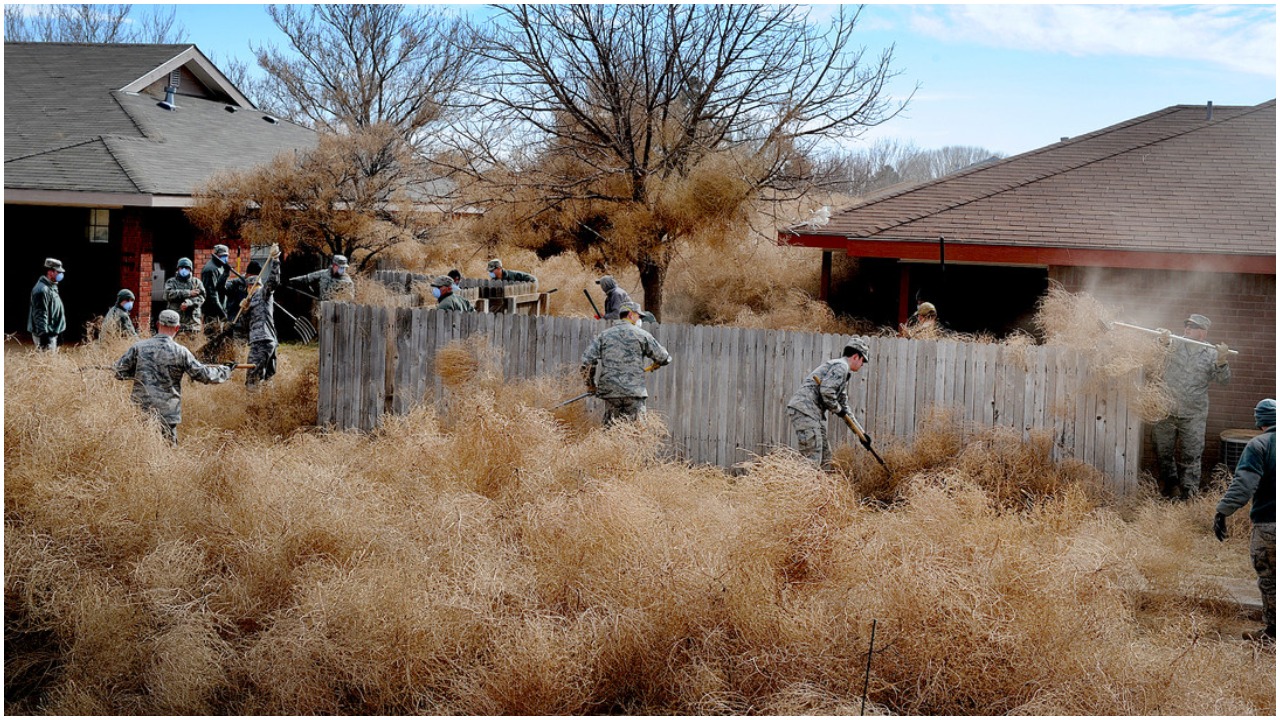Giant Tumbleweeds Are Taking Over California

Tumbleweeds are plants that dry out and break away from their roots in late summer. The wind blows the dried plants around, which is how it spreads its seeds.
Sometimes you can see them scudding along the landscape in movie Westerns, looking soft and relatively harmless, but that’s far from the truth. Because they are dry, they are often bristly and sharp, and can cause damage to animals or property that they run into.
Tumbleweed is a fact of life in certain parts of the American West, but there is one species of the plant which is both huge and unwilling to die out, even though it was supposed to be extinct by now, according to sciencealert.com.
The species is called Salsola ryanii, and despite the fact that it can produce tumbleweeds of up to six feet tall, scientists hadn’t really paid it a lot of attention until around 2002 and it wasn’t considered to be anything to worry about. A study done in 2008 predicted that the plant wouldn’t be able to adapt well, or to spread to a larger range. The study was wrong.
Since S ryanii was first identified in California, it has been steadily spreading across the state, and scientists have finally figured out why.
Victorville neighborhood overrun by tumbleweeds! @CBSLA pic.twitter.com/pFzxZIIIQ4
— Tina Patel (@tina_patel) April 17, 2018
Norman Ellstrand, a geneticist from University of California, Riverside, described it as a nasty species, which was replacing other nasty varieties of the plant, because it is healthier than other American species of the plant.
The reason it’s so robust is that it’s relatively new, probably only having evolved in the last 25-100 years. S ryanii is a hybrid of two older invasive tumbleweed varieties. One of the species it comes from is native to Russia and China, and became invasive in the US.
I come back to college at 3 a.m. and I’m greeted by a giant Tumbleweed in the elevator pic.twitter.com/5bjWESAreD
— ? Bolt the Spooky-Pony ? (@SuperPonyBolt) May 28, 2019
The other ‘parent’ species is native to South Africa and Australia, and has likewise become invasive in California and Arizona. The two species spawned S ryanii, and like any good child, it took the strongest traits of its parents and went on to make its way in the world. Or, at least, in California.
Not only does this monster tumbleweed get its robustness from its parents, it’s got multiple sets of chromosomes. Organisms which have multiple sets of chromosomes are called polyploids, but S ryanii takes it a step further, yet. It’s an alloploid, an organism whose multiple sets of chromosomes come from more than one taxon (a population of organisms which scientists see as a group).
Ellstrand says that plants which are alloploids are believed to be healthier than other plants of similar type which aren’t alloploids. They tend to be genetically suited to survive competition with it’s already establish parent species. Or so scientists had supposed, at any rate. There hasn’t been much actual research to back it up.
Giant hybrid tumbleweed spreads across California https://t.co/Ha4dE1f7ug by @mattyhick pic.twitter.com/wGyGaF53l7
— MotherNatureNetwork (@MotherNatureNet) April 1, 2016
Because of the lack of existing research, scientists conducted a two-year experiment in a test garden in California, to see how S ryanii held up against its two parent species. At the end of the that time, it was clear that the hybrid tumbleweed outclassed both its parents in terms of both volume and plant mass, indicators of a plant’s overall health.
Put another way, the new variety of tumbleweed is stronger and even more invasive than the two species that spawned it and, between them, the parent species have already spread across 48 states.
No one who follows issues like this was surprised to learn that the increased invasiveness of the new species was causing problems. In 2002, when S ryanii was first found, it was only located in two sites in California.
Ten years later, it could be found at 15 sites around the state. That level of spread in that short a time frame represents the largest known population number expansion of a new plant species, and may also be the most dramatic increase in range, as well.
Another Article From Us: An Underpopulated Region in Italy Will Pay You 25,000 Euros Just To Live There
Between its increasing numbers, size, and the fact it’s spreading so quickly, scientists are going to be watching it closely in the future, in hopes that it doesn’t get out of hand.
